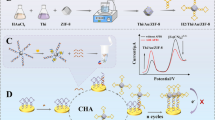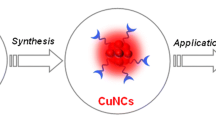Abstract
A novel assay for histidine and cysteine has been constructed based on modulation of fluorescent copper nanoclusters (CuNCs) by molecular switches. In our previous work, a dumbbell DNA template with a poly-T (thymine) loop has been developed as an excellent template for the formation of strongly fluorescent CuNCs. Herein, for the first time, we established this biosensor for sensing two amino acids by using dumbbell DNA-templated CuNCs as the single probe. Among 20 natural amino acids, only histidine and cysteine can selectively quench fluorescence emission of CuNCs, because of the specific interaction of these compounds with copper ions. Furthermore, by using nickel ions (Ni2+) and N-ethylmaleimide as the masking agents for histidine and cysteine respectively, an integrated logic gate system was designed by coupling with the fluorescent CuNCs and demonstrated selective and sensitive detection of cysteine and histidine. Under optimal conditions, cysteine can be detected in the concentration ranges of 0.01–10.0 μM with the detection limit (DL) of as low as 98 pM, while histidine can be detected in the ranges of 0.05–40.0 μM with DL of 1.6 nM. In addition, histidine and cysteine can be observed with the naked eye under a hand-held UV lamp (DL, 50 nM), which can be easily adapted to automated high-throughput screening. Finally, the strategy has been successfully utilized for biological fluids. The proposed system can be conducted in homogeneous solution, eliminating the need for organic cosolvents, separation processes of nanomaterials, or any chemical modifications. Overall, the assay provides an alternative method for simultaneous detection of cysteine and histidine by taking the advantages of high speed, no label and enzyme requirement, and good sensitivity and specificity, and will satisfy the great demand for determination of amino acids in fields such as food processing, biochemistry, pharmaceuticals, and clinical analysis.

Graphical abstract





Similar content being viewed by others
References
Mirzaei H, Suarez JA, Longo VD. Protein and amino acid restriction, aging and disease: from yeast to humans. Trends Endocrinol Metab. 2014;25:558–66.
Zhang SY, Ong CN, Shen HM. Critical roles of intracellular thiols and calcium in parthenolide-induced apoptosis in human colorectal cancer cells. Cancer Lett. 2004;208:143–53.
Shahrokhian S. Lead phthalocyanine as a selective carrier for preparation of a cysteine-selective electrode. Anal Chem. 2001;73:5972–8.
Gazit V, Ben-Abraham R, Coleman R, Weizman A, Katz Y. Cysteine-induced hypoglycemic brain damage: an alternative mechanism to excitotoxicity. Amino Acids. 2004;26:163–8.
Watanabe M, Suliman ME, Qureshi AR, Garcia-Lopez E, Bárány P, Heimbürger O, et al. Consequences of low plasma histidine in chronic kidney disease patients: associations with inflammation, oxidative stress, and mortality. Am J Clin Nutr. 2008;87:1860–6.
Leebeek FWG, Kluft C, Knot EAR, Demaat MPM. Histidine-rich glycoprotein is elevated in mild liver-cirrhosis and decreased in moderate and severe liver-cirrhosis. J Lab Clin Med. 1989;113:493–7.
Chen GN, Wu XP, Duan JP, Chen HQ. A study on electrochemistry of histidine and its metabolites based on the diazo coupling reaction. Talanta. 1999;49:319–30.
Li BX, Zhang ZJ, Liu ML, Xu CL. Flow injection chemiluminescence determination of L-cysteine in amino acid mixture and human urine with the BrO(3)(-)-quinine system. Anal Bioanal Chem. 2003;377:1212–6.
Gao C, Fan S. Influence of zone stacking sequences on CL intensity and determination of histidine in sequential injection analysis. Anal Lett. 2008;41:1335–47.
Wu J, Xu K, Landers JP, Weber SG. An in situ measurement of extracellular cysteamine, homocysteine, and cysteine concentrations in organotypic hippocampal slice cultures by integration of electroosmotic sampling and microfluidic analysis. Anal Chem. 2013;85:3095–103.
Xiao Q, Gao H, Yuan Q, Lu C, Lin JM. High-performance liquid chromatography assay of cysteine and homocysteine using fluorosurfactant-functionalized gold nanoparticles as postcolumn resonance light scattering reagents. J Chromatogr A. 2013;1274:145–50.
Barbaro E, Zangrando R, Vecchiato M, Turetta C, Barbante C, Gambaro A. D- and L-amino acids in Antarctic lakes: assessment of a very sensitive HPLC-MS method. Anal Bioanal Chem. 2014;406:5259–70.
Possari R, Carvalhal RF, Mendes RK, Kubota LT. Electrochemical detection of cysteine in a flow system based on reductive desorption of thiols from gold. Anal Chim Acta. 2006;575:172–9.
Feng L, Wu L, Xing F, Hu L, Ren J, Qu X. Novel electrochemiluminescence of silver nanoclusters fabricated on triplex DNA scaffolds for label-free detection of biothiols. Biosens Bioelectron. 2017;98:378–85.
Chen ZG, Liu JB, Han YL, Zhu L. A novel histidine assay using tetraphenylporphyrin manganese (III) chloride as a molecular recognition probe by resonance light scattering technique. Anal Chim Acta. 2006;570:109–15.
Hu Y, Wang Q, Zheng C, Wu L, Hou X, Lv Y. Recyclable decoration of amine-functionalized magnetic nanoparticles with Ni2+ for determination of histidine by photochemical vapor generation atomic spectrometry. Anal Chem. 2014;86:842–8.
Zhang Y, Yang RH, Liu F, Li KA. Fluorescent sensor for imidazole derivatives based on monomer-dimer equilibrium of a zinc porphyrin complex in a polymeric film. Anal Chem. 2004;76:7336–45.
Shao N, Jin JY, Cheung SM, Yang RH, Chan WH, Mo T. A spiropyran-based ensemble for visual recognition and quantification of cysteine and homocysteine at physiological levels. Angew Chem Int Ed. 2006;45:4944–8.
Sun SK, Tu KX, Yan XP. An indicator-displacement assay for naked-eye detection and quantification of histidine in human urine. Analyst. 2012;137:2124–8.
Chen S, Tian J, Jiang Y, Zhao Y, Zhang J, Zhao S. A one-step selective fluorescence turn-on detection of cysteine and homocysteine based on a facile CdTe/CdS quantum dots-phenanthroline system. Anal Chim Acta. 2013;787:181–8.
Liu YR, Hu R, Liu T, Zhang XB, Tan W, Shen GL, et al. Label-free dsDNA-Cu NPs-based fluorescent probe for highly sensitive detection of L-histidine. Talanta. 2013;107:402–7.
Shi F, Liu S, Su X. Dopamine functionalized-CdTe quantum dots as fluorescence probes for L-histidine detection in biological fluids. Talanta. 2014;125:221–6.
Bian W, Wang F, Wei Y, Wang L, Liu Q, Dong W, et al. Doped zinc sulfide quantum dots based phosphorescence turn-off/on probe for detecting histidine in biological fluid. Anal Chim Acta. 2015;856:82–9.
Chen X, Gong F, Cao Z, Zou W, Gu T. Highly cysteine-selective fluorescent nanoprobes based on ultrabright and directly synthesized carbon quantum dots. Anal Bioanal Chem. https://doi.org/10.1007/s00216-018-0980-3.
Zhang Y, Jiang J, Li M, Gao P, Zhou Y, Zhang G, et al. Colorimetric sensor for cysteine in human urine based on novel gold nanoparticles. Talanta. 2016;161:520–7.
Yu Y, Yang J, Xu X, Jiang Y, Wang B. A novel fluorescent probe for highly sensitive and selective detection of cysteine and its application in cell imaging. Sensors Actuators B Chem. 2017;251:902–8.
Miao Q, Li Q, Yuan Q, Li L, Hai Z, Liu S, et al. Discriminative fluorescence sensing of biothiols in vitro and in living cells. Anal Chem. 2015;87:3460–6.
Pu F, Huang Z, Ren J, Qu X. DNA/ligand/ion-based ensemble for fluorescence turn on detection of cysteine and histidine with tunable dynamic range. Anal Chem. 2010;82:8211–6.
Li H, Liu J, Fang Y, Qin Y, Xu S, Liu Y, et al. G-quadruplex-based ultrasensitive and selective detection of histidine and cysteine. Biosens Bioelectron. 2013;41:563–8.
Sun J, Yang F, Zhao D, Chen CX, Yang XR. Integrated logic gate for fluorescence turn-on detection of histidine and cysteine based on Ag/Au bimetallic nanoclusters-Cu2+ ensemble. ACS Appl Mater Interfaces. 2015;7:6860–6.
Wu C, Fan D, Zhou C, Liu Y, Wang E. Colorimetric strategy for highly sensitive and selective simultaneous detection of histidine and cysteine based on G-quadruplex-Cu(II) metalloenzyme. Anal Chem. 2016;88:2899–903.
Xue SF, Lu LF, Wang QX, Zhang S, Zhang M, Shi G. An integrated logic system for time-resolved fluorescent “turn-on” detection of cysteine and histidine base on terbium (III) coordination polymer-copper (II) ensemble. Talanta. 2016;158:208–13.
Jadzinsky PD, Calero G, Ackerson CJ, Bushnell DA, Kornberg RD. Structure of a thiol monolayer-protected gold nanoparticle at 1.1 angstrom resolution. Science. 2007;318:430–3.
Tao Y, Li M, Ren J, Qu X. Metal nanoclusters: novel probes for diagnostic and therapeutic applications. Chem Soc Rev. 2015;44:8636–63.
Liu J. DNA-stabilized, fluorescent, metal nanoclusters for biosensor development. Trac-Trends Anal Chem. 2014;58:99–111.
Rotaru A, Dutta S, Jentzsch E, Gothelf K, Mokhir A. Selective dsDNA-templated formation of copper nanoparticles in solution. Angew Chem Int Ed. 2010;49:5665–7.
Qing Z, He X, He D, Wang K, Xu F, Qing T, et al. Poly (thymine)-templated selective formation of fluorescent copper nanoparticles. Angew Chem Int Ed. 2013;52:9719–22.
Wang Y, Cui H, Cao Z, Lau C, Lu J. Additive and enhanced fluorescence effects of hairpin DNA template-based copper nanoparticles and their application for the detection of NAD(+). Talanta. 2016;154:574–80.
Wang B, Gao Y, Li HW, Hu ZP, Wu Y. The switch-on luminescence sensing of histidine-rich proteins in solution: a further application of a Cu2+ ligand. Org Biomol Chem. 2011;9:4032–4.
Liu S, Shi F, Chen L, Su X. Tyrosine-functionalized CuInS2 quantum dots as a fluorescence probe for the determination of biothiols. Analyst. 2013;138:5819–25.
Zhou Y, Zhou TS, Zhang M, Shi GY. A DNA-scaffolded silver nanocluster/Cu2+ ensemble as a turn-on fluorescent probe for histidine. Analyst. 2014;139:3122–6.
Qiu SY, Miao M, Wang TX, Lin ZY, Guo LH, Qiu B, et al. A fluorescent probe for detection of histidine in cellular homogenate and ovalbumin based on the strategy of click chemistry. Biosens Bioelectron. 2013;42:332–6.
Huang ZZ, Pu F, Lin YH, Ren JS, Qu XG. Modulating DNA-templated silver nanoclusters for fluorescence turn-on detection of thiol compounds. Chem Commun. 2011;47:3487–9.
Funding
The study was financially supported by the National Natural Science Foundation of China (No. 21505023).
Author information
Authors and Affiliations
Corresponding author
Ethics declarations
Conflict of interest
The authors declare that they have no competing interests.
Human participation and rights
This study was approved by the Institutional Review Board at Fudan University, and the experiments were performed in accordance with the ethical standards.
Informed consent
The authors declare that urine samples were collected at the Fudan University and obtained with informed consent.
Electronic supplementary material
ESM 1
(PDF 616 kb)
Rights and permissions
About this article
Cite this article
Gu, Z., Cao, Z. Molecular switch-modulated fluorescent copper nanoclusters for selective and sensitive detection of histidine and cysteine. Anal Bioanal Chem 410, 4991–4999 (2018). https://doi.org/10.1007/s00216-018-1149-9
Received:
Revised:
Accepted:
Published:
Issue Date:
DOI: https://doi.org/10.1007/s00216-018-1149-9




